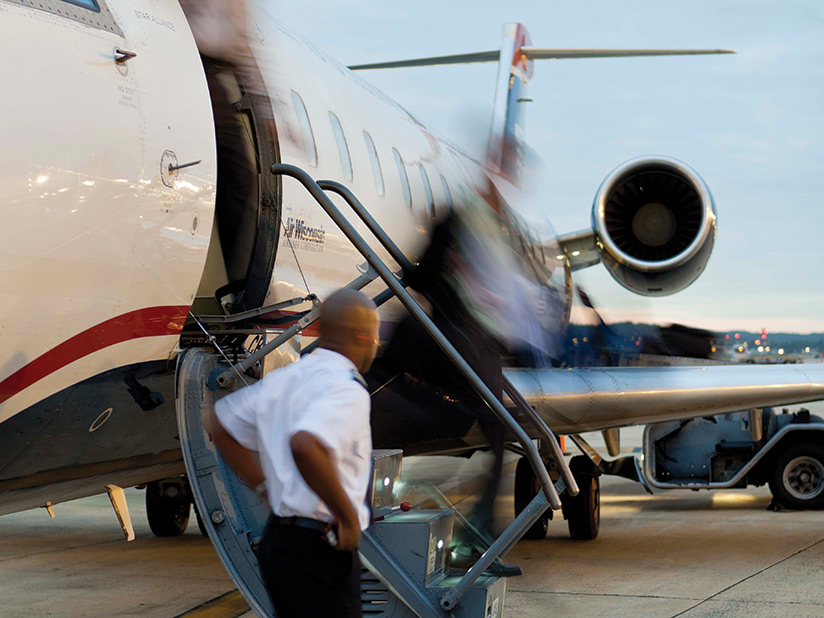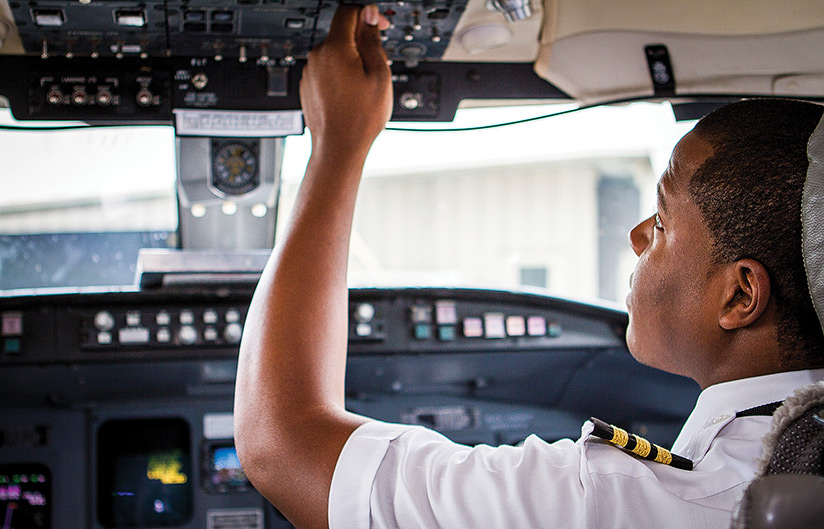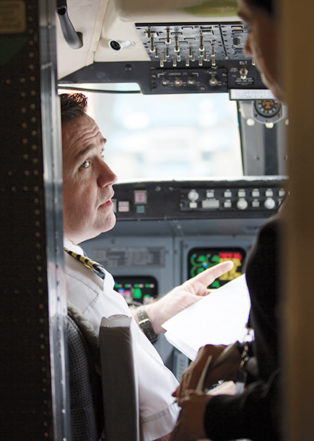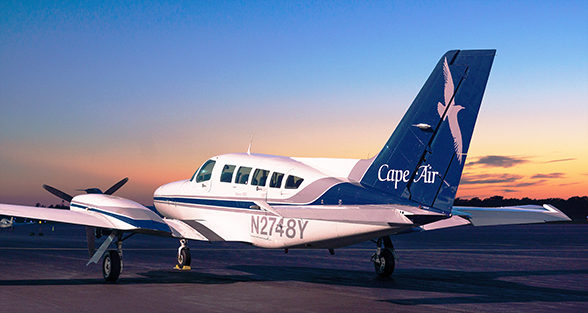
As they update pilot training over time, regional airline safety specialists can differ from their major airline counterparts in details of how they introduce operational risk mitigations, says Paul Kolisch, a captain and manager, flight operations training, Endeavor Air. Initiatives taking hold in major airlines — such as those focused on stabilized approaches; go-around decisions; aircraft state awareness; enhanced pilot monitoring; stall/upset prevention, recognition and recovery; and hand-flying skills — may require adaptations because of factors such as aircraft differences and even the ways that instructors make startle part of their line-oriented flight simulator scenarios, he said. The subject was part of his presentations to the World Aviation Training Conference and Tradeshow (WATS 2015) in Orlando, Florida, U.S., in April.
An example of major airline vs. regional airline procedural differences is the flight crews’ checklist memory item that, at the first indication of aerodynamic stall, calls for disconnecting automation. “All autopilots in regional transport aircraft disconnect when the stick shaker activates,” he said. “This does not happen in big airplanes. Very few regional airliners have autothrottles.”
In some regional airline simulator scenarios, the pilot flying is prompted to focus attention outside the cockpit to search for traffic in congested airspace by a “TRAFFIC” aural alert from the traffic-alert and collision avoidance system. At that moment, the simulator instructor initiates an airplane upset, Kolisch said, adding, “On some simulators, we can inject an upset at the push of a button [but] they are a little higher-drama than I would like. … When we first started discussing surprising people in the simulator at Stall/Stick Pusher Working Group meetings in 2010, it was met with tremendous resistance. In 11 years of using startle and surprise [in regional airline training], all the pilots are grateful for the experience.”

As to requiring regional airline pilots to periodically practice hand-flying skills during line operations — as promoted by policies of some major airlines — Kolisch expressed reservations but asked conference attendees for alternate views. “I think the place for it is in training. … This is something that needs to be brought into the simulators [to] validate that those skills are still there,” he said. “As a training person, I’m always sensitive to the appearance of micromanaging our pilots. I’m not a big fan of … mandating. If the guidance is clearly written about where the acceptable regimes are, I think that’s good.”
Dean McDavid, a captain and director of flight standards for United Airlines, responded that training must teach pilots when it is appropriate to increase the level of automation and when it is appropriate to decrease the level of automation. In a real-world scenario — such as flying a complex arrival into Los Angeles International Airport — the flight crew may have to change the level because of an alert from a knowledge-based system or because the automated system is not operating as it should, he said. Without this proficiency, flight crews “spend more time questioning the automation as opposed to changing their automation mode from fully automated to a manual mode [to] just simply fly the airplane,” he said. “Those are the skill sets I think we’re missing in training.”
Automation Culture
Today’s automation is the most complex yet and the most difficult to understand, said Paul Preidecker, a captain and chief flight instructor, Air Wisconsin Airlines. He noted that regional airline instructors have ample opportunity for observing how well first officers interact with automation and comparing this with voluntary reports about vertical and lateral flight path deviations that captains and first officers submit to the company’s aviation safety action program (ASAP). Flight path management with automation is essential for safety and for enabling the most efficient procedures possible such as optimum profile descents, in which the aircraft must “step accurately through all the arrival fixes.”
“Airlines have more access to these data, so that drives these discussions,” he said, noting that flight path deviations have been the predominant subject of his company’s ASAP reports. “How do we leverage the strong emotional appeal of automation that connects well with the current generation of students … against the perceived disadvantages of automation? I think we do it through training.”
He concurred with Kolisch that the automation capabilities of typical regional airline aircraft are significantly different from those of major airlines. Preidecker said, “For example, on a [Bombardier] CRJ 200, we have a function called vertical nav, but we can’t couple it to an autopilot. So at some point, when it’s time to ‘go downhill,’ [flight crews have] to think to themselves, ‘OK, let’s manage how we’re going to make this descent’ instead of always having the autopilot do it.”

He also encouraged simulator manufacturers to provide enough automatic-system malfunctions for regional airline simulator instructors to duplicate the scenarios that could happen in line operations. “Now, we can program a set of malfunctions for our pilot candidates, but we can’t show them everything,” he said.
Typically flying three to five legs each day, to and from airports of all sizes, U.S. regional airline pilots handle a wide variety of flight path management tasks. “We’re doing ‘six-hour’ flights an hour at a time — a much different relationship to automation than [for] a long-haul pilot. We have more opportunities to do some hand flying. … Some [pilots] favor automation, and some do not,” Preidecker said, pointing out normal circumstances that require manual operation. He cited Ronald Reagan Washington National Airport as an example, noting that no easy way exists to automate the “River Visual Rwy 19” approach. “You have to look out the window and be a pilot and fly down the river. We can’t turn the [heading-select] button fast enough to automate that,” he said.
Companies, therefore, have to balance time invested ensuring that pilots are experts in the automation they mostly use vs. maintaining proficient manual-flying skills. “On the one hand, we have FOQA [flight operational quality assurance] data showing us that we’ve never had an unstabilized approach flown on the autopilot,” Preidecker said. “But yet we really cannot create a policy that goes to our pilots and says, ‘You have to use the autopilot for every operation.’”
Among regional airlines that conduct initial and continuing qualification training under the U.S. Federal Aviation Administration’s (FAA’s) advanced qualification program, the prevailing practice now is simulator “scenarios that balance automation skills with manual flying during normal operations from point A to point B,” he said. New-hire pilots especially benefit from these scenarios when a regional jet also is their first jet experience. “We do insist that there is a core understanding of what’s going on behind the scenes with [the technology]. Day one, instead of pushing buttons, ought to be a return to basic flying, [the] pitch-power-trim relationships. … If it’s somebody’s first jet, they need to know some things before they can start pushing buttons.”
Express–Mainline Partnership
Safety cooperation and data sharing between an express carrier and a mainline partner have been vital for Air Wisconsin and American Airlines Group, which includes US Airways, Preidecker said. The regional airline safety specialists have taken strong interest in US Airways procedures that help mitigate an industrywide concern: noncompliance with standard operating procedures requiring a go-around when criteria of a stabilized approach are not met. “In our policy, it is up to the pilot monitoring to announce that the aircraft is ‘stable.’ US Airways found an interesting solution to this, which drives some interesting data,” he said. “Instead of relying on the non-flying pilot to say … ‘you’re stable,’” the pilot flying continually evaluates the situation, self-announces any approach parameters exceeding stabilized criteria and states his or her intentions. At 500 ft above ground level, however, the pilot monitoring calls “unstable, go around” if required after corrective action by the pilot flying.
“Some of us on the express side [of the industry] are adopting these procedures, or testing them, or looking at incorporating them because it’s hard to argue with the data [from US Airways],” he said. A US Airways presentation, he said, offers a reason for the reduction in unstabilized approaches: The pilot flying is forced to objectively evaluate the aircraft state. “It gets both people involved in the conversation, and the final aircraft state down around 500 ft is determined by the pilot monitoring,” Preidecker said.
First Officer Qualifications
Other presenters gave updates on U.S. regional airlines’ experiences complying with the FAA’s regulatory changes on minimum airline pilot qualifications (ASW, 9/10), which include an airline transport pilot certificate and 1,500 total hours of flight time, with flight hours reductions allowed through credit for university or military academic training.
Nancy Shane, vice president of training and employee development, Cape Air–Nantucket Airlines, presented findings of her late-2014 doctoral research, which studied the total flight hours when hired and the deidentified measures of performance of two groups of new-hire first officers during their initial training by the same regional air carrier operating under U.S. Federal Aviation Regulations Part 121. One measure was any difference in extra training events required; the other was any difference in training completions. The first group, which she called pre-FOQ (first officer qualifications), was hired before airline pilot qualification changes took effect in August 2013, and the second group, which she called post-FOQ, was hired afterward. The pre-FOQ dataset represented 184 pilots trained during 2005–2008. The post-FOQ dataset represented 232 pilots hired between August 2013 and November 2014.

Mean total flight time when the pre-FOQ pilots were hired was 1,654 hours; 44 percent had zero to 1,499 hours and 56 percent had 1,500 or more hours. In the post-FOQ group, the mean was 3,095 hours; 11 percent had zero to 1,499 hours and 89 percent had 1,500 or more hours. Shane’s comparative analysis found that 9 percent of pre-FOQ pilots required one or more extra training events versus 33 percent of post-FOQ pilots. This was a statistically significant result, she said, showing that “those hired after FOQ were more likely to require extra training than those hired before FOQ. Also significant was that the post-FOQ pilots who had 1,500 or more total flight hours “were more likely to require extra training events than those who were hired before FOQ.” No significant differences were found in the extra training events for the subgroups of pilots hired with zero to 1,499 hours.
Regarding training-completion outcomes, 4 percent of pre-FOQ pilots did not complete their training vs. 10 percent of post-FOQ pilots. This statistically significant result showed that “pilots hired after FOQ were less likely to complete training than those hired before FOQ,” Shane said.
“This was a single study with a single airline … so we need a more robust sample size,” she said, as well as data on characteristics of the individual pilots, such as their education and prior pilot background, to help explain her study’s findings. A post-FOQ Phase IV of the Regional Airline Association’s (RAA’s) Pilot Source Study, collecting data until September, will look at how individual characteristics relate to performance in regional airline training and line operations. This will help answer the question “How do pilots hired after Aug. 1, 2013, compare in source and training outcomes to pilots hired between 2005 and 2011?” Plans call for presenting the results in February 2016 at the Winter Meeting of the Aviation Accreditation Board International.
Stacey Bechdolt, vice president, safety and operations, and regulatory counsel of RAA, said that the intent of this regulatory change — published five years ago by the FAA — was to “ensure that all pilots entering air carrier operations have the background of training experience that will allow them to adapt.” RAA member airlines in 2015 are assessing whether first officers hired since August 2013 have been able to adapt as envisioned, she said. “From the narrative that we are hearing from our member airlines, and some of the data that we’re collecting right now, I offer that they are not,” Bechdolt said.
RAA was unsuccessful in proposing changes to the current regulation that would provide pilots additional credit hours for academic courses, as noted, toward the 1,500-hour requirement to become an airline pilot, Bechdolt said. “Where I think we’re going to see some movement is on … an enriched post-hire training environment, for lack of better words because we don’t know what that means yet [or] what it looks like. Does it mean … for an airline to ask the FAA to give [pilots] an exemption from certain hours if they have certain kinds of programs? It may look like that. It may be some kind of public-private partnership [between] a university and an airline.”
Meanwhile, regional airlines have “greatly extended [training] footprints” in the past few years and have made training adjustments but have not received any corresponding credit from the government that would address pilot shortages, Bechdolt said. “[Members of Congress now] want to understand that gap between leaving the university and becoming eligible to be hired at a regional airline. That lapse of time that didn’t exist before is becoming very interesting to Congress.”
Professional Pilot Development
Robert Burke, flight manager, FAA Air Carrier Flight Training Division, told the conference’s regional airline track that the agency has factored the safety performance of this industry segment into several initiatives.
He cited a high volume of public comments on a new advisory circular detailing the relevance and value of the voluntary, nonpunitive ASAP. FAA has worked to expand the routine use of ASAP by pilots of regional airlines, by flight attendants and by dispatchers at all airlines, and among personnel at companies flying under Part 135, commuter and on-demand operations, or operating under Part 145, repair stations.
A second FAA safety initiative relevant to regional airlines, originally called pilot mentoring, will be called pilot professional development under a proposed process for operations specification approval for training programs. “It’s going to consider leadership and mentoring training for [Part] 121 flight crewmembers and the establishment of professional pilot development programs at an air carrier,” Burke said, noting that the schedule calls for the details to be published in mid-2015 for public comment.
Featured image: © Ulf Wallin